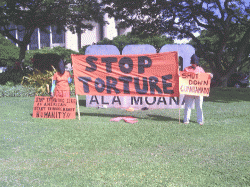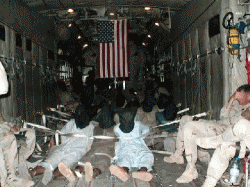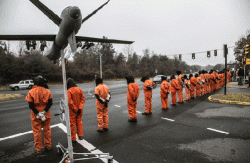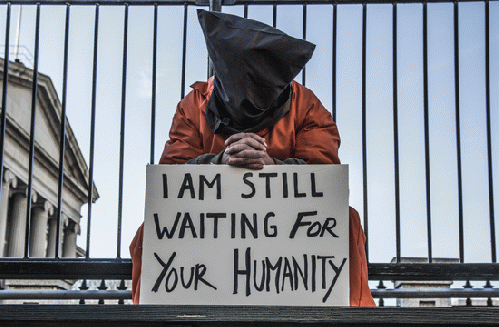By Ann Wright,
There are 166 out of 779 still imprisoned, including 87 cleared for release, but still held at Guantanamo
 January 11, 2013, marked the 11th year that the infamous Guantanamo prison has been in operation by the United States. It is also 11 years that Hamid Karzai has the leader of Afghanistan. On January 11, President Karzai met with Barak Obama, the second US president who has presided over the war in Afghanistan. We don't know if President Karzai mentioned the 18 Afghans who remain in Guantanamo out of the 220 who were imprisoned.
January 11, 2013, marked the 11th year that the infamous Guantanamo prison has been in operation by the United States. It is also 11 years that Hamid Karzai has the leader of Afghanistan. On January 11, President Karzai met with Barak Obama, the second US president who has presided over the war in Afghanistan. We don't know if President Karzai mentioned the 18 Afghans who remain in Guantanamo out of the 220 who were imprisoned.
But, no doubt there were discussions about the messy turnover of prisons in Afghanistan from US control to Afghan control, in which the US still refuses to hand over some prisoners. In 2012, 570 detainees were released after acquittal in Afghan courts with an additional 485 in the process of being released after a bilateral board of Afghans and Americans determined that there was not enough evidence to prosecute them. On the day prior to President Karzai's departure for Washington, another 80 prisoners were released.
It was 11 years ago, in late January, 2002, when I was on a helicopter that flew then interim-president Karzai from Kabul to Bagram Air Base for him to board a military aircraft for a flight to Washington, DC to meet with President Bush for the first time and for Karzai to be seated next to Laura Bush in the US Capitol gallery for President Bush's 2002 State of the Union message. At the time, I was in the US diplomatic corps and was on the small team that had reopened the US Embassy in Kabul, Afghanistan in mid-December, 2001.
 Eleven years ago, on January 10 or January 11, another military plane had flown from Bagram Air Base. It was a secret flight known to only a few very senior US officials (I was not one of them) and CIA and military personnel needed to carry out the flight. The plane carried 20 passengers, all strapped down on the icy floor of the plane, hands and feet cuffed, wearing blacked out eye goggles to they couldn't see and wearing diapers so their captors would not have to take them to the toilet in the long 22-hour flight from Afghanistan to Cuba. These were the first of what ended up being 779 prisoners, many of whom the United States government bought in a bounty program ($5,000 to $25,000 for al Qaeda members and $1 million for Osama bin Ladin) who were flown from sites all over the world to be locked up and tortured in a new prison constructed on the US Naval Base at Guantanamo, Cuba.
Eleven years ago, on January 10 or January 11, another military plane had flown from Bagram Air Base. It was a secret flight known to only a few very senior US officials (I was not one of them) and CIA and military personnel needed to carry out the flight. The plane carried 20 passengers, all strapped down on the icy floor of the plane, hands and feet cuffed, wearing blacked out eye goggles to they couldn't see and wearing diapers so their captors would not have to take them to the toilet in the long 22-hour flight from Afghanistan to Cuba. These were the first of what ended up being 779 prisoners, many of whom the United States government bought in a bounty program ($5,000 to $25,000 for al Qaeda members and $1 million for Osama bin Ladin) who were flown from sites all over the world to be locked up and tortured in a new prison constructed on the US Naval Base at Guantanamo, Cuba.
Eleven years later, here are the statistics that make Guantanamo a word of infamy (with apologies to those who live in the city of Guantanamo, Cuba). Statistics are from Reprieve, a UK human rights group, and Human Rights First...
- 779 persons have been imprisoned in Guantanamo since January 11, 2002.
- 166 prisoners are still detained in Guantanamo.
- 603 prisoners have been released.
- 1 Guantanamo prisoner has been convicted by US federal courts (Ahmed Ghalilani).
- 9 have died in Guantanamo, 6 allegedly by suicide and 3 of "natural causes." (3 from Afghanistan, 3 from Saudi Arabia and 3 from Yemen).
- Only 6 of the 779 prisoners have been put before a military commission.
- 4 prisoners eventually agreed to plea bargains.
- 1 prisoner has been convicted in a military commission.
- 1 prisoner is still at trial.
- 87 prisoners of the 166 (one-half) have been "cleared for transfer" by senior officials six US government agencies, but have not been released.
- 90 of the 166 are from Yemen, 18 from Afghanistan, 8 from Saudi Arabia, 7 from Algeria, 6 from Pakistan, 5 from Tunisia, 4 from China, 4 from Libya, 3 the Palestinian Territories, 3 from Syria, 2 from Mauritania, 2 from Uzbekistan, 2 from Malaysia, 2 from Sudan, 2 from Kuwait and one each from Kenya, Indonesia, Russia, Morocco, Somalia, Bosnia, Iraq and Tajikistan.
- 30 of those cleared for release are from Yemen and are being held until "conditions in the country improve," which means with US drone strikes in Yemen increasing, they will not be released for a long time, much less the other 60 from Yemen.
- Only 16 prisoners are considered "high value" (3 from Pakistan, 2 from Afghanistan, 2 Saudi Arabia, 2 Yemen, 2 Malaysia, 1 Indonesia, 1 Somalia, 1 Palestinian Territories, 1 Iraq, 1 Libya).
- 36 prisoners have now been designated for trial.
- 46 prisoners have been designated by the Obama administration for indefinite detention without charge or trial.
- 38 prisoners have been determined to be held unlawfully by US Federal Courts.
- $27,251 -- yearly cost to US taxpayers of a federal prisoner.
- $800,000 -- yearly cost to US taxpayer of a Guantanamo prisoner.
- $150 million -- yearly cost to operate Guantanamo.
- Nearly 500 persons have been convicted by Federal Courts since 9/11 on terror-related charges.
- 355 persons convicted in Federal Courts of terror-related charges currently are being held in US Federal prisons.
- 0 persons convicted in Federal Courts of terror-related charges have escaped from any part of the Federal prison system.
- 4 cases involving Guantanamo prisoner rights have gone to the US Supreme Court.
- In all 4 cases involving Guantanamo prisoner rights, the Supreme Court justices have sided with the prisoners.
During the 11 years of Guantanamo prison operations, hundreds of prisoners have gone on extended hunger strikes for treatment according to the Geneva conventions and reasonable condition such as having clean water bottles with meals. Military personal force-fed hunger strikers through painful nasal tubes.
Deaths in Guantanamo
Nine prisoners have died in Guantanamo, including three who allegedly committed suicide in one night in 2006 in separate cells by gagging themselves with their own socks, each tying their own hands behind their backs and then each one hoisting himself high enough to fall and then strangle to death. The US government says that another prisoner committed suicide in 2007, another in 2009 and the latest in 2012. Three prisoners reportedly died of "natural causes" -- heart attacks and cancer.
The latest prisoner to die in Guantanamo is Yemen citizen Adnan Farhan Abdul Latif who allegedly committed suicide in September, 2012 in solitary confinement at age 36, after nearly 11 years of imprisonment. Latif was never charged with a crime. He was purchased in the bounty program in Pakistan where he had gone for medical treatment and transported to Guantanamo on January 17, 2002.
Four years later in 2006, he was cleared by Department of Defense for return home. He was cleared again in 2008 and 2009. In 2010, a US District Court ordered his release, but a Court of Appeals overturned the release order. In December, 2012, his body was returned to his family in Yemen -- with many unanswered questions about his imprisonment and death.
The US military claims he committed suicide from an overdose of prescription medication complicated by acute pneumonia while in solitary confinement, monitored by camera and observed frequently by guards and medical staff who should have maintained rigorous strict medical protocols for a prisoner with acute pneumonia.
It took three months for the US government to return his body to Yemen. The US government autopsy and toxicology reports are classified and are being withheld from his family. His body was too decomposed for a second autopsy to be performed in Yemen. A short moving documentary about the return of his body to Yemen in December, 2012 is here.
Some Prisoners are too Dangerous to Take to Court?
The Obama administration mirrors the Bush administration's view that some of the remaining prisoners (Obama administration says 46) are too dangerous to go before a court when actually the danger for the administration is not from the prisoners but from having to acknowledge in a court, the US government's illegal torture techniques used on the prisoners.
But, so far, US administrations have successfully prevented any punishment for the hundreds of CIA, military and contractors that have been involved in the torture of prisoners in Guantanamo, Bagram and other prisons in Afghanistan, Iraq and in locations around the world. Senior CIA officials publicly and proudly acknowledge they destroyed interrogation tapes of "high value" prisoners.
Protests of Guantanamo Prison
For 10 years, American citizens and people around the world, have been protesting the illegal imprisonment and torture of prisoners at Guantanamo. Two groups even travelled to Cuba and held vigils outside the back gates of Guantanamo. In December, 2005, a group of 25 Catholic Workers walked 70 miles from the city of Santiago de Cuba to Guantanamo to bring more international publicity to the conditions in the Guanatamo prison.
In January, 2007, I was part of a CODEPINK: Women for Peace delegation that held a conference in the city of Guantanamo about the conditions for prisoners in US prison in Guantanamo and then held a 12-hour vigil at the back gate of the US Naval Base of Guantanamo.
British citizen Asaf Iqbal, one of first prisoners to be released from Guantanamo, came with us. We showed the documentary movie "The Road to Guantanamo" about his "capture" in Afghanistan and his ordeal in Guantanamo to over 1,000 Cubans in the largest movie theater in Guantanamo. When we asked if he were afraid to return to Cuba, he said, "No, I'm not afraid of Cuban, its just the Americans in Cuba I am worried about."
The mother and brother of Omar Deghayes, a man who was still a prisoner in Guantanamo, also came with us. During the vigil at the back fence of Guantanamo, Omar's mother cried and asked, "Do you think Omar knows we are here?" Omar was released at the end of 2007 and later told his mother that a guard mentioned to him that he had seen on TV that an international delegation had been at the back fence and the newscast said that Omar's mother there.
 Now, on January 11, 2013, six years after our trip to Guantanamo and 11 years after Guantanamo opened, we are still calling for Guantanamo prison to be closed. Vigils were held in cities all over the United States for the closing of Guantanamo. In Washington, DC, concerned citizens joined with Witness Against Torture in vigils at the White House, Supreme Court and Congress.
Now, on January 11, 2013, six years after our trip to Guantanamo and 11 years after Guantanamo opened, we are still calling for Guantanamo prison to be closed. Vigils were held in cities all over the United States for the closing of Guantanamo. In Washington, DC, concerned citizens joined with Witness Against Torture in vigils at the White House, Supreme Court and Congress.
And this year, with the opening of the movie at the Newsmuseum in Washington, DC about the execution of Osama Bin Ladin, "Zero Dark Thirty," Witness Against Torture participants in the notorious orange jumpsuits have brought attention to the waterboarding of prisoners in Guantanamo as graphically depicted in the movie.
This year, on January 11, I was home in Honolulu, Hawaii. Several of us from Hawaii Peace and Justice and World Can't Wait held a vigil in front of the Federal Building in Honolulu reminding our fellow citizens that torture is wrong, imprisonment without trial is wrong and the Guantanamo prison must close.
On the island of Oahu, with 4 major US military bases and a huge National Security Agency (NSA) installation, there are undoubtedly military and civilian personnel who have been guards, interrogators, medical and psychological specialists, lawyers and administrators who know exactly what has gone on in Guantanamo.
We felt it was important to remind them, as well as our fellow citizens, that we should end torture, close Guantanamo and "Stop Thinking like an American and Start Thinking about Humanity."


